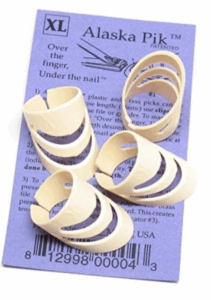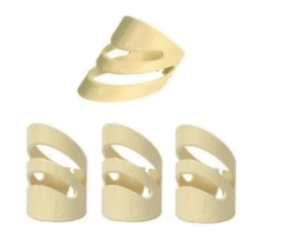Guitar fingerpicks opens up a whole new world of guitar playing. Instead of using a pick, you use your fingers to pluck the strings directly. This technique lets you play multiple parts at once – melody, bass and rhythm all together. It’s like being a one-person band.
Fingerpicking: Getting Starting
 If you’re getting into fingerpicking, you might want to try fingerpicks. These are small metal or plastic picks that fit over your fingertips. The Alaska Pik brand makes some great ones that many players love. They come in different sizes to fit various fingers comfortably.
If you’re getting into fingerpicking, you might want to try fingerpicks. These are small metal or plastic picks that fit over your fingertips. The Alaska Pik brand makes some great ones that many players love. They come in different sizes to fit various fingers comfortably.
The Alaska Pik fingerpicks have a simple design that works well. They’re made of lightweight metal that bends easily to fit your fingers. The part that touches the string is shaped to give a clear, bright tone. Unlike some picks that feel awkward at first, these mold to your fingers naturally.
What I like about these picks is how they protect your nails while still giving that fingerpicked sound. If you play a lot, your nails can wear down or break. The Alaska Piks let you keep playing without worrying about damaging your natural nails.
Also Read:
Alternate picking: Alternating Downstrokes and Upstrokes for Efficiency
10 Best Electric Guitar Pickups
Selecting the Best Guitar Pick
8 Most Important Guitar Picking Techniques
FingerPick Tone
The tone you get with these picks is really nice – bright but not too harsh. They bring out more volume than bare fingers, which helps when playing with other musicians. The metal gives a crisp attack that cuts through nicely without sounding artificial.
Putting them on takes a little practice at first. You bend the band to fit snugly around your finger, not too tight. The picking part should extend just past your fingertip. Once you get them adjusted right, they stay in place well while playing.
These picks work great for different fingerpicking styles. Whether you’re playing blues, folk or classical, they give you that clear, articulate sound. The thumb pick in particular helps bring out strong bass notes while keeping the higher strings sounding balanced.
Playing Fast Patterns
One thing beginners notice is how much easier it is to play fast patterns with these picks. Your fingers glide off the strings more smoothly compared to bare fingers. This helps when learning tricky alternating bass patterns or quick melodic runs.
The Alaska Piks come in different gauges – light, medium and heavy. I’d suggest starting with medium. They’re stiff enough to give good tone but still comfortable for long playing sessions. You can always try heavier or lighter ones later as you get used to them.
These picks really shine when you need projection. If you’re playing acoustic guitar in a group setting, they help your playing be heard clearly. The extra volume comes in handy without having to dig in too hard with your fingers.
Maintenance is simple – just wipe them clean after use. The metal holds up well over time, though you might need to adjust the fit occasionally as they can loosen slightly with extended use. A quick squeeze with pliers tightens them right up again.
Natural Playing
 Some players worry that fingerpicks will feel unnatural. The Alaska Piks have a good balance – you can still feel the strings while getting that enhanced tone. It’s not like playing with thick plastic picks that completely separate you from the strings.
Some players worry that fingerpicks will feel unnatural. The Alaska Piks have a good balance – you can still feel the strings while getting that enhanced tone. It’s not like playing with thick plastic picks that completely separate you from the strings.
For fingerstyle players who alternate between picking and strumming, these work well. The thumb pick doubles nicely for strumming when needed. You get the articulation of fingerpicking with the option to switch to a fuller strummed sound when the song calls for it.
If you’re just starting with fingerpicking, don’t feel you need picks right away. But once you’re comfortable with the basic technique, the Alaska Piks can take your playing further. They’re affordable enough to try without a big investment.
One tip for using them – start with just the thumb pick at first if the finger picks feel strange. Get used to that before adding the finger picks. This gradual approach helps your hand adjust to the different feel compared to bare fingers.
The clarity these picks provide really helps when learning new patterns. You can hear each note distinctly, which makes correcting mistakes easier. This immediate feedback speeds up the learning process for complex fingerstyle arrangements.
Recording on Guitar
For recording, many players find these picks give a more consistent tone than natural nails. Nails can vary in thickness and shape, leading to uneven string attacks. The Alaska Piks produce the same tone from each finger for balanced recordings.
They’re also great for players who can’t grow long nails. Whether due to work, hobbies or just personal preference, not everyone can maintain nails for fingerpicking. These picks solve that problem while still delivering authentic fingerstyle tone.
If you play multiple styles, these picks adapt well. They work for traditional fingerpicking, hybrid picking (pick plus fingers), and even some classical pieces. The versatility makes them useful as your playing evolves in different directions.
Picking Adjustments
 Remember that like any new gear, there’s an adjustment period. Your first session with fingerpicks might feel awkward. Give it a few days of regular playing before deciding if they’re right for you. Most players who stick with them find they become second nature quickly.
Remember that like any new gear, there’s an adjustment period. Your first session with fingerpicks might feel awkward. Give it a few days of regular playing before deciding if they’re right for you. Most players who stick with them find they become second nature quickly.
The Alaska Pik fingerpicks are widely available at music stores and online. They come in sets with thumb and finger picks, or you can buy them separately. This lets you customize which fingers you want to use them on based on your playing style.
Good fingerpicks can also help you in this important way:

Subscribe to continue reading
Subscribe to get access to the rest of this post and other subscriber-only content.
